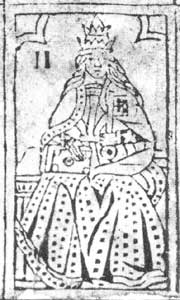This article includes a list of general references, but it lacks sufficient corresponding inline citations .(May 2024) |

The High Priestess (II) is the second Major Arcana card in cartomantic Tarot decks. It is based on the 2nd trump of Tarot card packs. In the first Tarot pack with inscriptions, the 18th-century woodcut Tarot de Marseilles, this figure is crowned with the Papal tiara and labelled La Papesse, the Popess, a possible reference to the legend of Pope Joan.
Contents
- History
- La Papesse
- Other variants
- Sister Manfreda
- Symbolism
- Rider–Waite symbolism
- Tarot of Marseilles symbolism
- Interpretation
- References
- Works cited
- Further reading
- External links
In the creation of the Rider–Waite Tarot deck, the Popess of the playing card packs was changed into The High Priestess of cartomantic cards. She wears a crown similar to the one used by the goddess Hathor, and is depicted with Marian imagery. A. E. Waite, the co-creator of the Rider–Waite deck, speculated that the card was connected to the ancient cult of Astarte or Mary as a representation of the Mother goddess. [1]

